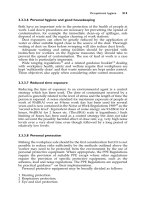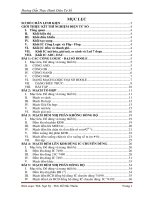E 194 10 (2015)
Bạn đang xem bản rút gọn của tài liệu. Xem và tải ngay bản đầy đủ của tài liệu tại đây (74.35 KB, 3 trang )
Designation: E194 − 10 (Reapproved 2015)
Standard Test Method for
Acid-Insoluble Content of Copper and Iron Powders1
This standard is issued under the fixed designation E194; the number immediately following the designation indicates the year of
original adoption or, in the case of revision, the year of last revision. A number in parentheses indicates the year of last reapproval. A
superscript epsilon (´) indicates an editorial change since the last revision or reapproval.
4.2 The insoluble matter consists of those nonmetallic
substances that do not dissolve in the mineral acid used to
dissolve the metal. In copper powder, which is treated with
nitric acid, the acid-insoluble matter includes silica, insoluble
silicates, alumina, clays, and other refractory materials that
may be introduced either as impurities in the raw material or
from the furnace lining, fuel, etc.; lead sulfate may also be
present. In iron powder, which is treated with hydrochloric
acid, the insoluble matter may include carbides in addition to
the substances listed above. The test method excludes insoluble
material that is volatile at the ignition temperature specified.
1. Scope
2
1.1 This test method covers the determination of the
mineral-acid-insoluble matter content of copper and iron powders in amounts under 1.0 %.
1.2 This standard does not purport to address all of the
safety problems, if any, associated with its use. It is the
responsibility of the user of this standard to establish appropriate safety and health practices and determine the applicability of regulatory limitations prior to use.
2. Referenced Documents
2.1 ASTM Standards:3
B215 Practices for Sampling Metal Powders
E50 Practices for Apparatus, Reagents, and Safety Considerations for Chemical Analysis of Metals, Ores, and
Related Materials
E691 Practice for Conducting an Interlaboratory Study to
Determine the Precision of a Test Method
5. Interferences
5.1 Any metallic tin present in the copper powder will be
converted into the insoluble tin oxide by the nitric acid
treatment; in such cases, provision shall be made for the
determination of tin oxide and the appropriate correction
applied.
6. Apparatus
3. Summary of Test Method
6.1 Apparatus and reagents shall conform to the requirements prescribed in Practices E50.
3.1 The sample is dissolved in the appropriate acid: nitric
acid (HNO3) for copper, hydrochloric acid (HCl) for iron. The
insoluble matter is filtered out and ignited in a furnace at
980 °C for 1 h.
6.2 Hot Plate.
6.3 Muffle Furnace, capable of operating at 980 °C.
6.4 Casseroles (non-metallic), 250 mL and 750 mL.
4. Significance and Use
6.5 Glass Funnel.
4.1 The purpose of this test method is to determine the
amount of gangue, refractory, inert, etc., materials, that may
adversely affect compacting tools and sintered properties of
components formed from copper and iron powders.
6.6 Quart or Porcelain Crucible.
6.7 Desiccator.
6.8 Analytical Balance, having a sensitivity of 0.1 mg.
6.9 Filter Paper, Whatman No. 541 or one of equivalent
pore size and ash content.
1
This test method is under the jurisdiction of ASTM Committee B09 on Metal
Powders and Metal Powder Products and is the direct responsibility of Subcommittee B09.02 on Base Metal Powders.
Current edition approved Oct. 1, 2015. Published June 2010. Originally approved
in 1962. Last previous edition approved in 2010 as E194 – 10. DOI: 10.1520/
E0194-10R15.
2
Based on the method developed by the Metal Powder Association (now the
Metal Powder Producers Association of the Metal Powder Industries Federation)
and described in MPIF Standard 06, “Determination of Acid Insoluble Matter in
Iron and Copper Powders,” which is a standard of the MPIF.
3
For referenced ASTM standards, visit the ASTM website, www.astm.org, or
contact ASTM Customer Service at For Annual Book of ASTM
Standards volume information, refer to the standard’s Document Summary page on
the ASTM website.
6.10 Vapor Collection System, suitable to provide adequate
operator protection from chemical vapors resulting from the
acid digestion steps and muffle furnace ignition steps.
7. Reagents
7.1 Hydrochloric Acid HCl (1:1).
7.2 Hydrochloric Acid HCl (1:25).
7.3 Nitric Acid (HNO3).
7.4 Nitric Acid HNO3 (1:1).
Copyright © ASTM International, 100 Barr Harbor Drive, PO Box C700, West Conshohocken, PA 19428-2959. United States
1
E194 − 10 (2015)
IRON POWDER
7.5 Ammonium Iodide (NH4I).
7.6 Potassium Thiocyanate (5%).
11. Procedure
8. Sampling
11.1 Transfer 5 g of the sample, weighed to the nearest
0.0001 g, to a 750 mL covered casserole.
8.1 The metal powder shall be sampled in accordance with
Practices B215.
NOTE 3—Some operators report better reproducibility when increasing
the metal powder sample size to 10 g. Nevertheless, the precision
statement listed in Section 14 was based on 5 g samples.
8.2 Store the test sample in a tightly stoppered bottle to
protect it from moisture which promotes oxidation of copper
and iron.
11.2 With caution, add 100 mL of HCl (1:1) (Note 4), and
let stand at room temperature until the reaction is complete.
COPPER POWDER
11.3 Heat the solution to boiling on a hot plate. Maintain
boiling for about 1 min. Then add 150 mL of water, and reheat
to boiling and maintain for about 1 min.
9. Procedure
9.1 Transfer 5 g of the sample, weighed to the nearest
0.0001 g, to a 250 mL covered casserole.
9.2 Add 100 mL of HNO3 (1:1) and let stand at room
temperature until the reaction is complete.
11.4 Filter the hot solution, and wash the residue alternately
with hot HCl (1:25) and hot distilled water, six times with each,
to ensure the removal of all iron salts. The absence of iron salts
in the filtrate may be checked by the addition of a 5 % solution
of potassium thiocyanate. If iron salts are present the filtrate
will turn blood-red.
9.3 Place the casserole on a hot plate and boil until the
volume is reduced to 50 mL.
NOTE 4—If it is desired to exclude carbides from the reported insoluble
matter, add 20 mL of HNO3 to the HCl (1:1).
9.4 Cool, dilute with distilled water to about 100 mL, and
bring to a boil. Maintain boiling for about 1 min.
11.5 Prepare a quartz or porcelain crucible by pre-heating
for 40 min in air at 980 °C and then cool it in a dessicator.
NOTE 1—Some operators report better reproducibility when increasing
the metal powder sample size to 10 g. Nevertheless, the precision
statement listed in Section 14 was based on 5 g samples.
9.5 Filter the hot solution, and wash with hot distilled water
until all traces of blue color (copper salts) disappear.
11.6 Weigh the crucible to the nearest 0.0001 g.
11.7 Transfer the filter paper and residue to the crucible.
9.6 Prepare a quartz or porcelain crucible by pre-heating for
40 min in air at 980 °C and then cool it in a desiccator.
11.8 Dry, and then ignite in a furnace at 980 °C for 1 h.
9.7 Weigh the crucible to the nearest 0.0001 g.
11.9 Cool in a desiccator and reweigh to the nearest
0.0001 g. The difference in mass is the insoluble matter.
9.8 Transfer the filter paper and residue to the crucible.
9.9 Dry, and then ignite in a furnace at 980 °C for 1 h.
12. Calculation
9.10 Cool in a desiccator and reweigh to the nearest
0.0001 g. The difference in mass is the insoluble matter.
Reserve the residue.
12.1 Calculate the percentage of insoluble matter as follows:
Insoluble matter, percent 5 @ A/B # 3 100
NOTE 2—If the ignited residue reserved from 9.2 is suspected to contain
tin oxide, add 5 g of NH4I to the crucible. Reheat the crucible and contents
in air with a bunsen burner to a dull-red temperature or place in a furnace
at 600 °C minimum for 15 min or until all fumes have been dispelled.
Remove the crucible from the heat and cool. Add 2 to 3 mL of HNO3,
evaporate to dryness, ignite and weigh to the nearest 0.0001 g. Repeat the
treatment with NH4I and HNO3 until constant mass is obtained. The loss
in mass represents tin oxide. Subtract this loss in mass from the mass of
insoluble matter determined in 9.10 to calculate the insoluble fraction that
is free of tin oxide.
where:
A = insoluble matter, g, and
B = sample used, g.
13. Report
13.1 Report the total insoluble matter as a percentage to the
nearest 0.01 %.
10. Calculation
14. Precision and Bias
10.1 Calculate the percentage of insoluble matter as follows:
14.1 Precision—The following precision data were developed using the procedures contained in Test Method E194 from
an interlaboratory study that performed six sets of tests. The
percent insoluble was determined for four samples: a –325
mesh iron, a –60 mesh iron, a –325 mesh copper, and a –60
mesh copper. The different particle sizes were used to determine if there were any effects on the precision of testing based
on differences in particle size distribution. Practice E691 was
Insoluble matter, percent 5 @ ~ A 2 B ! /C # 3 100
where:
A
= insoluble matter, g,
B
= correction for grams of tin oxide, if present (Note 2),
and
C
= sample used, g.
2
E194 − 10 (2015)
followed for the design and analysis of the data; the details are
given in an ASTM Research Report.4
14.1.1 The precision information given below is for the
comparison of two test results. The results were obtained from
the running of three replicates in each test on each sample.
Average, %
Sr, %
SR, %
r, %
R, %
–325
Iron
0.29
0.022
0.051
0.06
0.14
–60
Iron
0.08
0.012
0.025
0.03
0.07
–325
Copper
0.11
0.013
0.036
0.04
0.10
14.1.2 Duplicate results from the same laboratory should be
considered acceptable at the 95 % confidence level unless they
differ by more than r, the repeatability interval.
14.1.3 Duplicate results from two different laboratories
should be considered acceptable at the 95 % confidence level
unless they differ by more than R, the reproducibility interval.
–60
Copper
0.09
0.019
0.063
0.05
0.18
14.2 Bias—No information can be presented on the bias of
the procedure in Test Method E194 for measuring the acid
insoluble content of copper and iron powders because no
material having an accepted reference value is available.
15. Keywords
4
Supporting data have been filed at ASTM International Headquarters and may
be obtained by requesting Research Report RR:B09-1009.
15.1 acid insolubles; copper powder; iron powder
ASTM International takes no position respecting the validity of any patent rights asserted in connection with any item mentioned
in this standard. Users of this standard are expressly advised that determination of the validity of any such patent rights, and the risk
of infringement of such rights, are entirely their own responsibility.
This standard is subject to revision at any time by the responsible technical committee and must be reviewed every five years and
if not revised, either reapproved or withdrawn. Your comments are invited either for revision of this standard or for additional standards
and should be addressed to ASTM International Headquarters. Your comments will receive careful consideration at a meeting of the
responsible technical committee, which you may attend. If you feel that your comments have not received a fair hearing you should
make your views known to the ASTM Committee on Standards, at the address shown below.
This standard is copyrighted by ASTM International, 100 Barr Harbor Drive, PO Box C700, West Conshohocken, PA 19428-2959,
United States. Individual reprints (single or multiple copies) of this standard may be obtained by contacting ASTM at the above
address or at 610-832-9585 (phone), 610-832-9555 (fax), or (e-mail); or through the ASTM website
(www.astm.org). Permission rights to photocopy the standard may also be secured from the Copyright Clearance Center, 222
Rosewood Drive, Danvers, MA 01923, Tel: (978) 646-2600; />
3









